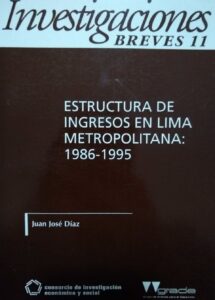Estructura de ingresos en Lima Metropolitana: 1986-1995
| Year | : | 1999 |
|---|---|---|
| Author/s | : | Juan Jose Diaz |
| Area/s | : | Employment, productivity and innovation, State reform and public institutions |
Díaz, J. J. (1999). Estructura de ingresos en Lima Metropolitana: 1986-1995. Lima: CIES. Investigaciones Breves, 11.
The research analyzes the evolution of relative income among labor force groups defined by gender, education and experience.
It seeks to determine whether the evolution of relative income during the 1986-1995 period can be explained by shifts in labor supply or by shifts in demand. A disaggregated non-parametric approach, called the domestic product test, is used, which evaluates whether shifts in relative supply are sufficient to explain temporal changes in relative income. In this case it shows that the hypothesis of neutral relative demand does not hold, making it necessary to incorporate demand factors into the analysis.
The estimation of relative job demand shifts indicates that less skilled women and higher skilled men experience the largest increases in their demands. The decomposition of the changes in income differentials by gender and educational levels explained by changes in relative labor demand indicates that the effect of changes in employment structures within economic sectors would have had greater importance in the evolution of the income structure.







